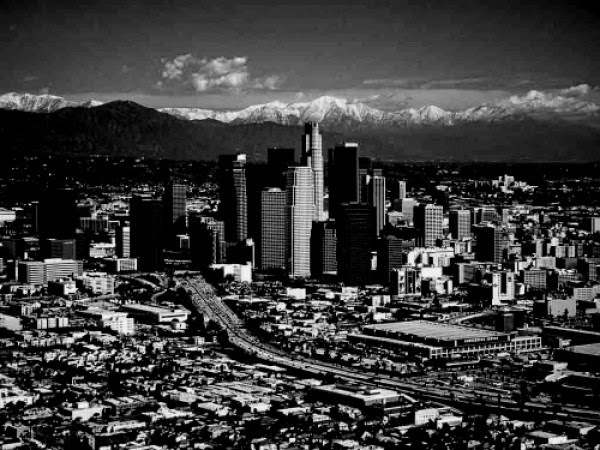
In this documentary Thom Anderson explores the tangled relationship between the movies and their fabled hometown, Los Angeles. Entirely from the perspective of the films themselves.
“This is the city: Los Angeles, California. They make movies here. I live here. Sometimes I think that gives me the right to criticize the way movies depict my city.
I know it’s not easy. The city is big. The image is small. Movies are vertical. At least when they’re projected on a screen. The city is horizontal, except for what we call downtown. Maybe that’s why the movies love downtown more than we do. If it isn’t the site of the action, they try to stick its high-rise towers in the back of the shot.
But movies have some advantages over us.
They can fly through the air. We must travel by land.
They exist in space. We live and die in time.
So why should I be generous?
Of course, I know movies aren’t about places, they’re about stories. If we notice the location, we are not really watching the movie. It’s what’s up front that counts. Movies bury their traces, choosing for us what to watch, then moving on to something else.”
Voice-over by Thom Andersen1
“People call Los Angeles Plays Itself an essay film; personally, I prefer to call it a documentary. I think that when you go see a documentary film, you should learn something, and I don’t think that’s such a radical idea, actually. Of course we learn from a good fiction film as well, although maybe it’s a different type of truth. I think all films should aspire toward truth, but people misunderstand the idea when it comes to movies. They think of truth as being accuracy, and that is unobtainable by the nature of film, which is selection by framing and editing. Truth is simply an aspiration, like any other classic virtue–charity, for example. Sometimes you may give money to a beggar, but other times you keep walking.”
Thom Andersen2
“With the finesse of a personable human rights lawyer, Andersen rockets through the clustered wrongs of Hollywood. Pointing out early that most studios reside in Culver City, not in Hollywood, Los Angeles Plays Itself addresses ‘Hollywood’ primarily as an idea, and one with a consistently shifting definition. It distances itself from L.A., though at the same time siphoning from its sprawl decades’ worth of money-making – and Andersen interprets Hollywood’s implementation of the unfortunate abbreviation as a strategy for diminution, tutelage. Los Angeles, Thom Andersen’s hometown, has figured, it seems, for most of its existence, as a misunderstood mutant, a territory without definitive identity, despite now serving as residence to nearly four million people. A McDonald’s restaurant in the City of Industry remains forever closed to the public, but functions exclusively as a set for commercials. The Bradbury Building has been cast as a Mandalay locale or as the headquarters of an East Coast newspaper. Frank Lloyd Wright’s Ennis House has provided context for such varying visions as that of Bladerunner (Ridley Scott, 1982), House on Haunted Hill (William Castle, 1959) (a cheesy Vincent Price joint), and a Ricky Martin music video. Hollywood refuses to take Los Angeles for what it is, Andersen insists, if the professionals that make up the movie machine have any clue about its essence to begin with. Hollywood denigrates what should represent the pride of Los Angeles’s eclectic architectural scene, casting its Modernist and International style homes as dens of iniquity, the mansions of gangsters and drug lords, rather than centers for evolved living. Moreover ‘conventional ideology trumps personal conviction’ just as geographic license provides a cover for lazy writing. Runaway rapscallions find shelter in Malibu beach houses–some kind of Reagan-era joke, no doubt–and landmarks are renamed, relocated to serve inept plot twists.”
Peter Moysaenko3
- 1Thom Andersen, “Los Angeles Plays Itself,” Diagonal Thoughts, 20 February 2015.
- 2Thom Andersen, “Thom Andersen talks about his films and politics,” interview by Travis Diehl, Artforum, 3 June 2016.
- 3Peter Moysaenko, “Thom Andersen Tarnishes The Silver: Los Angeles Plays Itself,” Bomb Magazine, 7 December 2009.

